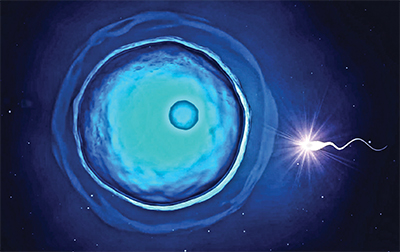MCP: Sperm-quality study updates advice for couples
Could doctors at fertility clinics be giving men bad advice? Two clinician–researchers at the Center for Reproductive Medicine of Shengjing Hospital in Shenyang, China, think so.
Research from Da Li and XiuXia Wang’s labs, published in the journal Molecular & Cellular Proteomics, upends conventional wisdom that abstaining between efforts to conceive can improve a couple’s chances of success. The research team worked with almost 500 couples to test whether how long a couple waits between efforts to conceive could change their success rate.
 An artist’s representation of fertilization of an oocyte by a sperm cell.Courtesy of Karl-Ludwig Poggemann/Flickr
An artist’s representation of fertilization of an oocyte by a sperm cell.Courtesy of Karl-Ludwig Poggemann/Flickr
“For years, men have usually been advised to limit sexual activity to increase the chances of pregnancy,” said Li. “However, it’s time to change our minds.”
Some earlier studies had shown that semen produced shortly after a man’s most recent ejaculation — within three hours or so — had faster and more motile sperm than if the man abstained for several days before ejaculating again. But it wasn’t clear why the sperm changed or whether the changes affected fertility. So researchers set up a few side-by-side experiments.
They looked at individual subjects’ semen after they had abstained for either several days or just an hour or two, comparing the volume of semen and the mobility of sperm. As had been observed earlier, the sperm from shorter abstinence periods moved faster.
Using mass spectrometry to look at the protein makeup of the samples, the team found major molecular differences. The majority of the affected proteins were involved in cell adhesion, a function that sperm need in order to fuse with egg cells.
The team also observed changes to proteins involved in sperm motility and metabolism, especially proteins that handle reactive oxygen species, a byproduct of cellular energy production. Although reactive oxygen species are needed for some normal sperm functions, an excess can damage sperm’s genetic material.
According to Li and Wang’s results, the longer sperm exist, the more vulnerable they are to DNA damage by reactive oxygen, which could harm their ability to form a viable embryo.
To see whether the changes to sperm were affecting fertility, the research team also ran a study of about 500 couples preparing for in vitro fertilization at the fertility clinic. They asked men in the control group for semen samples after several days of abstinence, whereas men in the experimental group abstained for less than three hours before providing their samples. The IVF team proceeded as usual with the two types of sample, using them to generate and then implant embryos.
“A typical live birth rate in a cohort of this size is about 30 percent,” Li said. In the experimental cohort, live births were higher by one-third.
“Our data indicate that couples with relatively normal semen parameters should have frequent sex around the ovulation period,” Li said. “This could make all the difference to their efforts to start a family.”
Meanwhile, IVF treatments at the Center for Reproductive Medicine, which treats about 5,000 infertile couples per year, also are being updated to use semen from more closely spaced ejaculations.
The team plans to continue working with patients, Li said, and will investigate differences in post-translational modifications that his lab saw between the types of samples. “This is a very new field,” he said, noting that there are many unanswered questions about the changes the team observed.
Enjoy reading ASBMB Today?
Become a member to receive the print edition four times a year and the digital edition monthly.
Learn moreGet the latest from ASBMB Today
Enter your email address, and we’ll send you a weekly email with recent articles, interviews and more.
Latest in Science
Science highlights or most popular articles

Mapping proteins, one side chain at a time
Roland Dunbrack Jr. will receive the ASBMB DeLano Award for Computational Biosciences at the ASBMB Annual Meeting, March 7–10, just outside of Washington, D.C.

Exploring the link between lipids and longevity
Meng Wang will present her work on metabolism and aging at the ASBMB Annual Meeting, March 7-10, just outside of Washington, D.C.

Defining a ‘crucial gatekeeper’ of lipid metabolism
George Carman receives the Herbert Tabor Research Award at the ASBMB Annual Meeting, March 7–10, just outside of Washington, D.C.

The science of staying strong
Muscles power every movement, but they also tell the story of aging itself. Scientists are uncovering how strength fades, why some species resist it and what lifestyle and molecular clues could help preserve muscle health for life.

Bacteriophage protein could make queso fresco safer
Researchers characterized the structure and function of PlyP100, a bacteriophage protein that shows promise as a food-safe antimicrobial for preventing Listeria monocytogenes growth in fresh cheeses.

Building the blueprint to block HIV
Wesley Sundquist will present his work on the HIV capsid and revolutionary drug, Lenacapavir, at the ASBMB Annual Meeting, March 7–10, in Maryland.

